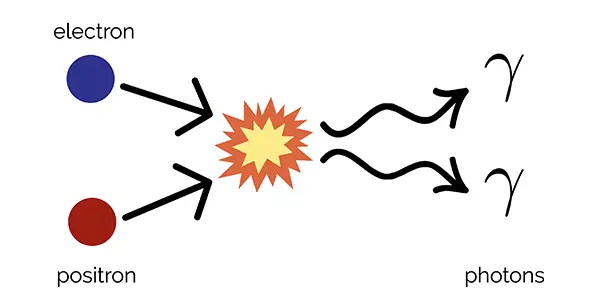Fantasy Science Pt. 24: ANGELS & DEMONS, Antimatter, And The “God Particle”

Radha has a PhD in theoretical quantum physics. Apart from…
Antimatter. Mass. The God Particle. Have you heard terms like these flying around the science fiction sections of the film/TV world? Have you ever wondered just how accurately these films portray real science? Well, my friends, today is your lucky day: this column, Fantasy Science & Coffee, aims to bridge the gap between science and science fiction in films and popular culture. My hope is to explain things in a fun way – like we’re chatting over coffee.
You may be thinking: who is this person, why does she think she can explain science, and why the heck would I want to have coffee with her? Well, I’m Radha, a researcher in India, who recently submitted a PhD thesis in theoretical quantum physics. I quite like hot beverages. I’ll also pay.

In this twenty fourth part of the series published on the second and fourth Tuesdays of every month, we are going chat about the substance that lies at the heart of the 2009 film Angels & Demons: antimatter.
Antimatter in Angels & Demons
Suppose you wanted to be the new Pope. You could, perhaps, head on over to CERN, steal a quarter gram of antimatter, have a hired assassin threaten to blow up Vatican City with the antimatter during the Papal Conclave, then swoop in to save the day at the last minute. Oh wait, that’s the plot of the 2009 film Angels & Demons, based on Dan Brown’s book with the same name. You’d have to think of a different plan.
Steering clear of the glaringly obvious ethical issues of this plan, how feasible is this idea in terms of science? The answer is: not feasible at all. Let’s take a look at what antimatter is to find out why.
What is Antimatter?
Matter is a physical substance that takes up space. You, me, those clothes at the back of your closet you never wear, and the electronic device you’re using to read this, are all made up of matter and possess a certain mass. What, then, does ‘antimatter’ refer to? You may think, the way I first did when I heard this word years ago, that antimatter is the complete opposite to matter in a way that it does something other than take up space and doesn’t possess mass. This isn’t true.
Scientifically, antimatter is practically the same as matter with one difference: an opposite charge. In fact, we could have as easily been made up of antimatter as we are of matter. After the Big Bang, there were equal amounts of antimatter and matter in the universe. But something happened shortly after the birth of our universe to make matter the dominant one of the two, and scientists still don’t know what.
When a particle collides with its antiparticle, there’s mutual annihilation, and energy is released. As an example, consider electrons, which are small negatively charged particles with a mass of 9.1 × 10^(-31) kilograms. An antielectron is called a positron, which has the same mass, but a positive charge. Positrons are not theoretical. They are emitted during certain radioactive decays, such as the decay of Potassium-40 — which means bananas emit positrons every so often.

When an electron and positron collide, they annihilate, and the energy is released as two photons, i.e., light particles. So when Robert Langdon, played by Tom Hanks, says “Vatican City will be consumed by light,” he is not wrong.
The thing about antimatter is that it is not only negligibly prevalent in our universe in comparison to matter, it is incredibly difficult to create and contain. As Harvard physicist, Prof. Gerald Gabrielse, told Live Science in 2009 when the film was released:
If you take all the antimatter produced in the history of the world and annihilated it all at once, you wouldn’t have enough energy to boil a cup of tea.
In the film, it is claimed that the stolen quarter gram of antimatter is equivalent to five kilotons of dynamite. This claim is true, however, creating that much antimatter would take billions of years, according to Prof. Rolf-Dieter Heuer, ex-Director-General of CERN.
One thing the film does get right is the the type of mechanism used to contain the antimatter. A suspension technique very similar to what the scientist, Vittoria, describes is used, because the antimatter is at risk of annihilating with its container:

The Truth About The God Particle
What may shed light on the matter-antimatter imbalance in our universe is studying the Higgs boson, popularly (but inaccurately) dubbed “the God particle”. What makes this particle so important that it cost the late Professor Stephen Hawking $100 in a bet? The Higgs boson is behind the formation of mass, and it’s the reason the universe isn’t just a formless soup.
When a particle moves through something called the “Higgs field,” the Higgs bosons, which are the elementary particles of the Higgs field, clump around it. The more bosons that clump around it, the larger the mass of the particle.

One of my favourite analogies was given by physicist, Prof. David Miller. Imagine a crowded c*cktail party. If, suppose, Angelina Jolie walked into the room, people would swarm around her. As more and more people joined her group, she would find it difficult to move across the room. If I entered the room, I would go virtually unnoticed. Only the welcoming host or a couple of people looking for a new friend would group around me, and so, I would be able to navigate the room with ease.
If Angelina and I were subatomic particles, she would have more mass than I (ha!). The people in the room are metaphorical Higgs bosons, and the room itself can be thought of as the Higgs field.
It is believed that studying the Higgs boson could help us better understand mass, matter, and potentially the antimatter-matter imbalance.
Now, why is it called the “God particle”? Unfortunately, this is a misnomer. While the Higgs boson helps solidify a theory behind the workings of the universe, it by no means is an indicator of God, and still does not answer many of the big questions physicists are facing today. Some of these include the explanations of gravity and dark matter. The late Nobel Laureate Leon Lederman coined the term “The God Particle” for the title of his book about the indispensability of the Higgs. While it is apparently an excellent book despite the title (I haven’t read it yet), the media has latched onto the unfortunate nickname. Lederman later semi-seriously defended the name by saying that the publisher wouldn’t let him call it “The Goddamn Particle”.
Talking About Particle Physics
Nowadays, using the term ‘God particle’ has thankfully appeared to taper off somewhat. It’s not an accurate nickname, and should be buried, in my opinion. But I do not begrudge its use in the film, when Vittoria says:
It’s a way of studying the origins of the universe, to isolate what some people call the God particle…it’s what gives all matter mass. The thing without which we could not exist.
This is because I truly appreciate just what the film did for particle physics. In 2009, the film got cinema goers around the world chatting about antimatter and the Higgs boson – something unthinkable! So, when CERN announced its discovery of the Higgs boson three years later, the world had already heard those terms, and people were genuinely curious to hear more. One may say that the power of the film industry far surpasses that of a quarter gram antimatter bomb.
More to Explore
Articles
Scientific American: Why Is There More Matter Than Antimatter? (2019)
Science Alert: The LHC Has Detected The Higgs Boson Again, This Time With a Massive Twist (2018)
Live Science: First-Ever Observation of Higgs Boson Decay Opens New Doors for Particle Physics (2018)
Wired: Could you build a banana-powered generator? (2013)
Reuters: “It’s a boson:” Higgs quest bears new particle (2012)
Wired: Angels & Demons: The Physics Behind the Movie (and the Book) (2011)
Reuters: Scientists debunk “Angels and Demons” antimatter (2009)
Phys.Org: Physicists Scrutinize Antimatter in Angels & Demons (2009)
Popular Mechanics: Does Angels & Demons Get Antimatter Science Right? (2009)
Nature Blogs: ATLAS: The Physics Behind Angels & Demons (2009)
LiceScience: The Truth about Angels, Demons and Antimatter (2009)
Resources
CERN: What is the God particle?
YouTube: Prof David Miller’s Higgs Boson Analogy
Books
The God Particle: If the Universe Is the Answer, What Is the Question? by Leon M. Lederman, Dick Teresi
Does content like this matter to you?
Become a Member and support film journalism. Unlock access to all of Film Inquiry`s great articles. Join a community of like-minded readers who are passionate about cinema - get access to our private members Network, give back to independent filmmakers, and more.
Radha has a PhD in theoretical quantum physics. Apart from research, she consults on sci-fi screenplays/books. In her free time, she cosplays and irritates her three cats. Bug her on Twitter: @RadhaPyari











